Area
Looking at the closed figures given below, can you tell which figure takes up more space on the flat surface?
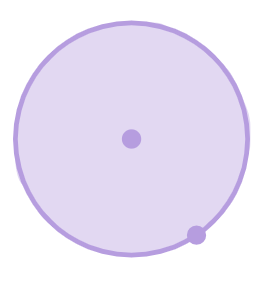


In order to check which shape takes up more space, we need to calculate area.
The amount of surface enclosed by a closed figure is called its area.
So, can you tell, which of the above figures has more area?
It is difficult to do so just by looking at these figures. So, what can be done?
One way is to place them on top of a squared paper or graph paper where every square measures (1 cm × 1 cm). After tracing an outline of the figure, count the number of squares enclosed by the figure.
Some of them are completely enclosed, some only around half the size, others less than half and so on. This isn't the most accurate way to calculate the area but is good enough to just get an approximate idea.
The area of the figure becomes the number of centimetre squares that are covered by it.
But what about the partially covered squares? One thing that can be done is to adopt a certain convention, say:
The area of one full square is taken as 1 sq. unit. If it is a centimetre square sheet, then area of one full square will be 1 cm2.
Ignore portions of the area that are less than half a square.
If more than half of a square is in a region, just count it as one square.
If exactly half the square is counted, take its area as 1/2 sq unit.
Area of a rectangle
Outline the said rectangle on a graph paper having 1 cm × 1 cm squares. The rectangle covers
Area of Rectangle =Number of Squares×Area of Each Square
Number of Squares: 15
Area of Each Square: 1
(since each square is 1 cm by 1 cm)
Calculation of Area:
Area of Rectangle = 15 × 1
Linking to Rectangle Dimensions:
No. of rows =
No. of columns =
Number of Squares = Rows x Columns:
Given Rectangle Dimensions:
L = 5 cm
B = 3 cm
Substituting in Area Equation:
Area of Rectangle = L × B = 5 cm × 3 cm = 15
Area of a rectangle = (length × breadth)
We can find the length and breadth by counting the squares along the sides.
Now without using the graph paper, can we find the area of a rectangle whose length is 6 cm and breadth is 4cm?
Understanding the Problem:
Length = 6 cm Breadth = 4 cm
It is a rectangle, which is a four-sided shape with opposite sides that are equal in length.
Formula for calculating the area:
Area = Length × Breadth
Substituting the Measurements:
Using the formula Area = Length × Breadth, substitute the given measurements.
Area = 6 cm × 4 cm = 24 cm² So the area of the rectangle with a length of 6 cm and a breadth of 4 cm is
Let's discuss the Area of a square.
Area of a square
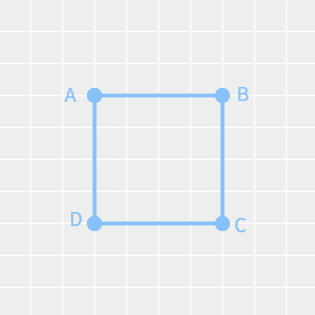
Let us now consider a square of side 4 cm. What will be its area? If we trace it on a centimetre graph paper, what do we observe?
It covers
i.e. the area of the square = 16 sq cm = 4 × 4 sq cm.
This is similar to how we dealt with the rectangle. What do we infer from this?
We find that in each case,
Area of the square = side × side
Let's solve the problems.
Let's Solve
The area of a rectangular piece of cardboard is 36 sq cm and its length is 9 cm. What is the width of the cardboard?
Understanding the Data:
Area of cardboard =
Length of cardboard =
Steps to Find the Width:
Area Formula:
Area = Length × Width
Substitute the Known Values:
Solve for the Width:
To find the width, divide the area by the length:
Width = Area / Length
Width =
Width =
Therefore, the width of the cardboard is
Now see the Area of a circle.
Area of a circle
Now, take the circle drawn on the squared paper (1 square = 1 x 1 cm), what will be the area? Using the convention, find the area of the circle on the graph paper and also calculate the area using the mathematical formula of Area of circle = πr2 . Also answer the questions given below:

Find area of circle.
Area using square counting:
Area using formula:
Difference between graph paper counting and obtained formula value :
The formula gives a higher value for area.
Bob wants to cover the floor of a room 3 m wide and 4 m long by squared tiles. If each square tile is of side 0.5 m, then find the number of tiles required to cover the floor of the room.
Answer :
Solution:
To find the number of square tiles needed to cover the floor of a room, we'll first calculate the area of the room and then the area of a single tile. By dividing the total area of the room by the area of a single tile, we can determine how many tiles are needed.
Understanding the Data Room Dimensions:
Width of the room =
Length of the room =
Tile Dimensions:
Side of each square tile =
undefined
Steps to Calculate the Number of Tiles
Calculate the Area of the Room:
Use the formula for the area of a rectangle: Area = Length × Width
Room Area =
Calculate the Area of a Single Tile:
Since the tile is square, its area is the side length squared: Area = Side × Side
Tile Area = 0.5 m × 0.5 m
Determine the Number of Tiles Needed:
Divide the total area of the room by the area of one tile: Number of Tiles = Room Area / Tile Area
By following these steps, we can calculate the exact number of tiles needed to cover the floor. Let's proceed with the calculations.
Number of tiles required = =
Based on the calculations, 48 square tiles, each with a side of 0.5 meters, are required to cover the floor of a room that is 3 meters wide and 4 meters long.
Calculate the approximate areas of the given figures by checking the number of squares covered (use the above mentioned convention):
Note: In case decimals, round it to one decimal place.
Fill the table and calculate the approximate area of the given curved figure by checking the number of squares (use the usual convention):

Calculate the estimate area
| Covered Area | Number | Area Estimate (sq units) |
|---|---|---|
| Fully-filled squares | ||
| Half-filled squares | ||
| More than half-filled squares | ||
| Less than half-filled squares | ||
| Total Area | - |
A piece of string is 30 cm long. What will be the length of each side if the string is used to form : (a) a square :
Square Perimeter = 4 x side-length
30 = 4 x side-length
side = = 7.5 cm
Now continue to next part.
(b) an equilateral triangle :
Equilateral triangle Perimeter = 3 x side-length
30 = 3 x side-length
side = = 10 cm
(c) a regular hexagon :
Regular Hexagon Perimeter = 6 x side-length
30 = 6 x side-length
side = = 5 cm
Avneet buys 9 square paving slabs, each with a side of 0.5m. He lays them in the form of a square.
(a) What is the perimeter of his arrangement ?
(b) Shari does not like his arrangement. She gets him to lay them out like a cross. What is the perimeter of her arrangement then?
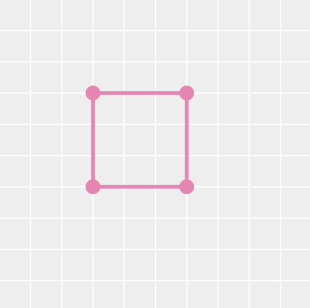
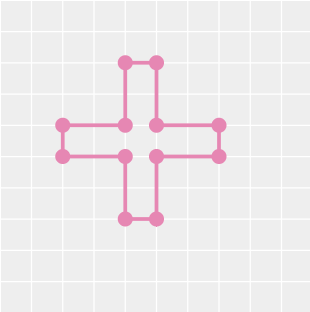
(c) Arrangement one has the greater perimeter
(d) Avneet wonders if there is a way of getting an even greater perimeter. Can you find a way of doing this? (The paving slabs must meet along complete edges i.e. they cannot be broken)
Solution:
(a) To form a square we have along each side, three 0.5m tiles. Therefore,
Each side of the square formed = 0.5 + 0.5 + 0.5 = 1.5 m
Thus,
Perimeter = 4 x side = 4 x 1.5 = 6 m
(b) Upon rearranging the tiles to form a cross we have:
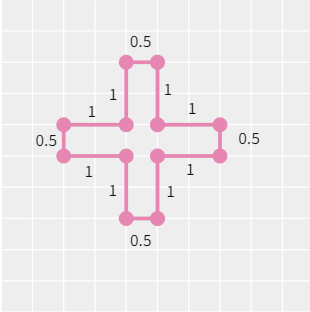
Therefore,
The total perimeter = 4 x 0.5 + 8 x 1 = 10 m
(c) From (a) and (b), we know that arrangement two has a higher perimeter.
(d) Using trial and error we find that if we arrange the tiles horizontally as shown:

The total perimeter of the arrangement = 10 m
Find the area in square metre of a piece of cloth 1m 25 cm wide and 2 m long.
Area:
Solution :
Length of the cloth = 2 m
Breadth of the cloth = 1 m 25 cm = 1 m + 0. 25 m = 1.25 m (25 cm = 0.25m)
Area of the cloth = length of the cloth × breadth of the cloth
= 2 m × 1.25 m = 2.50
